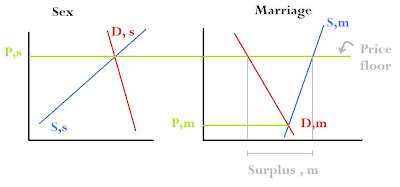From a Blog I Frequent:
I've decided that much of romance, courting, marriage, blah blah blah, seems to confuse a lot of people on both sides of the dating game. And I'm only half-jesting when I say this, but just some basic economics goes a long way in explaining the different phenomena we see in the courting/dating world. And it is because of this, I've decided to write a yet-to-be-determined number of pieces of the economics of courtship in that I've already come up with three and thought it might be worth writing about.
Today's topic is the "Two Tiered Market."
I cannot claim to have been the original observer of this phenomenon, it may have been Roissy, but it I think it was somebody perhaps a little less visceral (if anybody knows, please send the link my way), regardless, it was the observation that women in their late 20's to about their 40's believe or associate sex with marriage. Or, more specifically, that if they have sex with a man, they believe that is a representation or a proxy for his level of interest in marriage.
Now, again, when we delve into the courting world there are no databases, there are no records kept and so it largely goes based on anecdotal evidence and experience, but I would say not ALL women obviously fall for this, but some certainly do. So as a favor to them, not to mention codify this theory, permit me you this graph (I love that phrase);

What we have here is a classical supply and demand chart of two markets; the sexual market and the marriage market.
In the first market we have the demand for sex (presumably from men) and the supply of sex (presumably women) - (the roles actually do not matter as to who is the buyer and who is the supplier, you could switch them if you wanted, as long as you are consistent amongst both markets, you will get the same results). In general, men demand sex more than women. Yes, horribly politically incorrect of me, I know. Send the Speech-Police's best sniper after me, in the mean time it does not change the fact that it is true, so my death will avail nothing and no one. In any case, demand is high and relatively inelastic.
Also, in general, women in their late 20's to 40's are more or less over that initial fear or discomfort with sex. They are more comfortable with it, they certainly aren't just going to go willy nilly offering it all over the place, but their supply curve is what I would consider normal (yes, send in the Politically Correct Assassins).
The point where the two meet is the equilibrium point, where if you were paying attention in high school economics, is the "price" you pay for sex - denoted by P,s. In this metaphorical example it would be dinners men must take women out on, gas, psychological issues, the time dedicated to it, etc. etc.
Now notice the line, P,s, goes across to the other market, the marriage market.
The reason it does this is SOME women think that because a man has sex, that he is now interested in marriage. When in reality they are TWO SEPARATE AND DISTINCTLY DIFFERENT MARKETS. TWO SEPARATE AND DISTINCTLY DIFFERENT "GOODS AND SERVICES" AS THE ECONOMIC TERM IS.
However, in assuming sex=marriage, this brings about an economic phenomenon known as a "price floor." Meaning you cannot charge BELOW a certain price, or "below the floor." This is why P,s is carried over to the marriage market on that green line.
In the marriage market, women also supply marriage. For the ages of late 20's to 40's, women, in general, are more than willing to supply a LOT of marriage. But with this sex-induced psychological floor, they are led to believe that demand is much higher than it actually is (see line D,m to realize that men of equivalent marrying age do not demand marriage ANYWHERE NEAR as much as they demand sex, resulting in a free market price of marriage that is very low, P,m).
Now, because there is an effective price floor, this results in a price that is "too high." At that lofty price very few men are willing to demand or pay for a marriage. Whereas at that very high price, women are MORE THAN WILLING to supply it. This results in what economists call a "surplus"-denoted by the gray "Surplus, m."
A surplus of what? A surplus of women in the marriage market.
This is why I fear for (and have genuine pity for) women who mistake sex for marriage or at least perhaps more realistically, love and affection that may lead to marriage. It may not be seen too frequently in the late 20's as most men at that age are still willing to get married, but I doubt you know of some guy in his 40's who is dating some woman who "just won't commit."
Well, there you go, in economic-charty-goodness no less.
And that's, frankly that. I have nothing more to really add to it, because, well , it's economics. It's kind of cut and dry.
